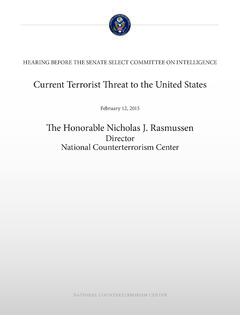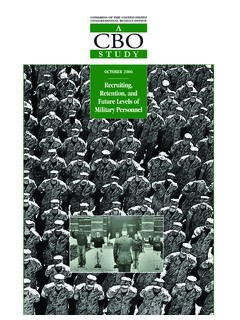Transcription of Explosions and Blast Injuries - Centers for Disease ...
1 Explosions and Blast Injuries A Primer for Clinicians Key Concepts Bombs and Explosions can cause unique patterns of injury seldom seen outside combat. The predominant post explosion Injuries among survivors involve standard penetrating and blunt trauma. Blast lung is the most common fatal injury among initial survivors. Explosions in confined spaces (mines, buildings, or large vehicles) and/or structural collapse are associated with greater morbidity and mortality.
2 Half of all initial casualties will seek medical care over a one-hour period. This can be useful to predict demand for care and resource needs. Expect an upside-down triage - the most severely injured arrive after the less injured, who bypass EMS triage and go directly to the closest hospitals. Background Explosions can produce unique patterns of injury seldom seen outside combat. When they do occur, they have the potential to inflict multi-system life-threatening Injuries on many persons simultaneously. The injury patterns following such events are a product of the composition and amount of the materials involved, the surrounding environment, delivery method (if a bomb), the distance between the victim and the Blast , and any intervening protective barriers or environmental hazards.
3 Because Explosions are relatively infrequent, Blast -related Injuries can present unique triage, diagnostic, and management challenges to providers of emergency care. Few health professionals have experience with explosive-related Injuries . Vietnam era physicians are retiring, other armed conflicts have been short-lived, and until this past decade, the was largely spared of the scourge of mega-terrorist attacks. This primer introduces information relevant to the care of casualties from explosives and Blast Injuries . As the risk of terrorist attacks increases in the , disaster response personnel must understand the unique pathophysiology of Injuries associated with Explosions and must be prepared to assess and treat the people injured by them.
4 Classification of Explosives Explosives are categorized as high-order explosives (HE) or low-order explosives (LE). HE produce a defining supersonic over-pressurization shock wave. Examples of HE include TNT, C-4, Semtex, nitroglycerin, dynamite, and ammonium nitrate fuel oil (ANFO). LE create a subsonic explosion and lack HE s over-pressurization wave. Examples of LE include pipe bombs, gunpowder, and most pure petroleum-based bombs such as Molotov cocktails or aircraft improvised as guided missiles. HE and LE cause different injury patterns.
5 Explosive and incendiary (fire) bombs are further characterized based on their source. Manufactured implies standard military-issued, mass produced, and quality-tested weapons. Improvised describes weapons produced in small quantities, or use of a device outside its intended purpose, such as converting a commercial aircraft into a guided missile. Manufactured (military) explosive weapons are exclusively HE-based. terrorists will use whatever is available illegally obtained manufactured weapons or improvised explosive devices (also known as IEDs ) that may be composed of HE, LE, or both.
6 Manufactured and improvised bombs cause markedly different Injuries . Blast Injuries The four basic mechanisms of Blast injury are termed as primary, secondary, tertiary, and quaternary (Table 1). Blast Wave (primary) refers to the intense over-pressurization impulse created by a detonated HE. Blast Injuries are characterized by anatomical and physiological changes from the direct or reflective over-pressurization force impacting the body s surface. The HE Blast wave (over-pressure component) should be distinguished from Blast wind (forced super-heated air flow).
7 The latter may be encountered with both HE and LE. Table 1: Mechanisms of Blast Injury Category Characteristics Body Part Affected Types of Injuries Primary Unique to HE, results from the impact of the over-pressurization wave with body surfaces. Gas filled structures are most susceptible - lungs, GI tract, and middle ear - Blast lung (pulmonary barotrauma) - TM rupture and middle ear damage - Abdominal hemorrhage and perforation - Globe (eye) rupture - Concussion (TBI without physical signs of head injury) Secondary Results from flying debris and bomb fragments Any body part may be affected - Penetrating ballistic (fragmentation) or blunt Injuries -Eye penetration (can be occult)
8 Tertiary Results from individuals being thrown by the Blast wind Any body part may be affected - Fracture and traumatic amputation - Closed and open brain injury Quaternary - All explosion -related Injuries , illnesses, or diseases not due to primary, secondary, or tertiary mechanisms. - Includes exacerbation or complications of existing conditions. Any body part may be affected - Burns (flash, partial, and full thickness) - Crush Injuries - Closed and open brain injury - Asthma, COPD, or other breathing problems from dust, smoke, or toxic fumes - Angina - Hyperglycemia, hypertension LE are classified differently because they lack the self-defining HE over-pressurization wave.
9 LE s mechanisms of Injuries are characterized as due from ballistics (fragmentation), Blast wind (not Blast wave), and thermal. There is some overlap between LE descriptive mechanisms and HE s Secondary, Tertiary, and Quaternary mechanisms. Table 2: Overview of Explosive-related Injuries System Injury or Condition Auditory TM rupture, ossicular disruption, cochlear damage, foreign body Eye, Orbit, Face Perforated globe, foreign body, air embolism, fractures Respiratory Blast lung, hemothorax, pneumothorax, pulmonary contusion and hemorrhage, A-V fistulas (source of air embolism)
10 , airway epithelial damage, a spiration pneumonitis, sepsis Digestive Bowel perforation, hemorrhage, ruptured liver or spleen, sepsis, mesenteric ischemia from air embolism Circulatory Cardiac contusion, myocardial infarction from air embolism, shock, vasovagal hypotension, peripheral vascular injury, air embolism-induced injury CNS injury Concussion, closed and open brain injury, stroke, spinal cord injury, air embolism-induced injury Renal Injury Renal contusion, laceration, acute renal failure due to rhabdomyolysis, hypotension, and hypovolemia Extremity injury Traumatic amputation, fractures, crush Injuries , compartment syndrome, burns, cuts, lacerations, acute arterial occlusion, air embolism-induced injury Note: Up to 10% of all Blast survivors have significant eye Injuries .
















